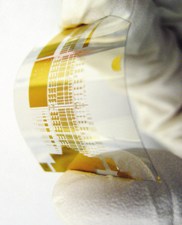Fast, Bendable Computers
A Already, flexible-but-slow polymer electronics have made their way into technologies like roll-up digital displays. If superfast silicon electronics could also be made flexible, we might be able to do things like weave computing devices into clothing, or mold antennas around an airplane’s fuselage, making for more precise radar. Now researchers at the University of Wisconsin-Madison have made ultrathin silicon transistors that are 50 times as fast as their predecessors.

Previously, researchers at the University of Illinois at Urbana-Champaign showed that nanometer-thin films of single-crystal silicon transistors could be made flexible. But Wisconsin researchers Zhenqiang Ma, professor of electrical and computer engineering, and Max Lagally, professor of materials science and physics, improved the transistors’ performance by putting strain on the silicon’s crystalline structure, increasing electron mobility. And by altering fabrication methods to reduce electrical resistance, Ma achieved a transistor speed of 7.8 gigahertz–fast enough for, say, a flexible sensor that could send and receive Wi-Fi signals. Ma says he expects to reach speeds of 20 gigahertz; military antennas are a likely first application.
Keep Reading
Most Popular
Large language models can do jaw-dropping things. But nobody knows exactly why.
And that's a problem. Figuring it out is one of the biggest scientific puzzles of our time and a crucial step towards controlling more powerful future models.
The problem with plug-in hybrids? Their drivers.
Plug-in hybrids are often sold as a transition to EVs, but new data from Europe shows we’re still underestimating the emissions they produce.
How scientists traced a mysterious covid case back to six toilets
When wastewater surveillance turns into a hunt for a single infected individual, the ethics get tricky.
Google DeepMind’s new generative model makes Super Mario–like games from scratch
Genie learns how to control games by watching hours and hours of video. It could help train next-gen robots too.
Stay connected
Get the latest updates from
MIT Technology Review
Discover special offers, top stories, upcoming events, and more.